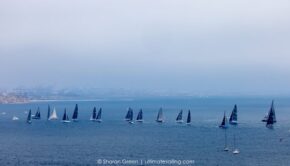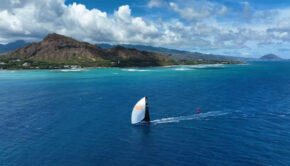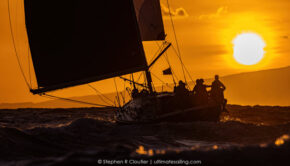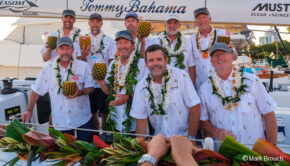Slow Second Start to Transpac
Published on July 11th, 2013
San Pedro, CA (July 11, 2013) – Unseasonably overcast rainy skies greeted the 21 starters today in the 2013 Transpacific Yacht Race from Los Angeles to Honolulu, or the Transpac. The teams representing Australian, Canada, Japan, and the USA set off at 1300 local time from the start line off Point Fermin in San Pedro at 1300 Pacific Daylight Time for the 2225-mile race to Diamond Head, just east of Honolulu.
These were very abnormal conditions for the start of this biennial ocean racing classic, with light and variable breezes from the south prompting teams to sail off the starting line on port tack, unlike most starboard tack starts. And the unusual conditions also had some teams already loaded with spinnakers on their bows and ready to deploy…normally these downwind sails are not seen until the second or third day of the race.
The current weather predictions have them in light and variable conditions throughout the remainder of today and through the night until they reach about 120° W longitude. There the influence of the coast starts fading away and the prevailing northwesterlies circulating around the Pacific High will start to reach this group to help get them farther and faster down the track.
The problem is that this is over 120 miles to the west of the start area, and at current rates of speed about 24 hours away for some boats, so it could be a long night ahead for these teams. It will stretch the memories of Transpac historians to remember when downwind gybing was needed to approach the West End of Catalina Island, the last point of North America these crews will see for the next week or more.
This slow progress for Divisions 4, 5 and 6 is in start contrast to the first wave of starters on Monday who shot off the coast with perfect 10-20 knot conditions and who are still enjoying this good breeze some 600 miles down the track towards Hawaii.
Division 8 leader on elapsed time is Bob Hayward’s Seastream 650 Manatea, who has stretched to over 50 miles ahead of the Ross Pearlman’s Jeanneau 52 Between the Sheets by barreling down the track at 9.3 knots. In corrected time, however, it is Rob Simonson’s Jeanneau 44 Sleeper that was leading this class at this morning’s 0600 roll call by nearly 2 hours over the runner-up, Matt Brooks’ classic S&S 52 Dorade.
The spread in Division 7 is much tighter, with only 26 miles separating the entire group of six boats, and two Japanese entries taking the lead. Yuichi Takahashi’s First 40 ten quarter and Hioshi Kitada’s X-41 KIHO were within a mile of each other in the morning roll call, while it was a third Japanese entry, Kazuhiro Nakajima’s R/P 44 Gefion, winning on corrected time by over 6 hours.
Meanwhile, Saturday’s starters in Divisions 0, 1 and 2 are in Long Beach using today and tomorrow for tuning and practicing…see the Transpac Facebook page for photos and videos of them in action.
Online spectators can follow the racer’s progress using the Yellowbrick tracking system which shows all the boat’s positions and information, like speed and course heading, and is updated every 6 hours.
A daily video analysis on the progress of the race will be provided by race veteran and Seahorse Magazine editor Dobbs Davis, with online access to the show also on the race website.
Photos, videos, and other resources are also available in the Media section of www.transpacyc.com, and Facebook and Twitter will provide ongoing news, photos, videos and commentary about the activities and people involved with the 2013 Transpac.
About the Transpac: Organized by the Transpacific Yacht Club, the Transpac is a 2225-mile race from Point Fermin in Los Angeles to Diamond Head, just east of Honolulu, a distance of 2225-miles. With its first running in 1906, this is among the world’s great ocean races, and biennially attracts the world’s most talented offshore sailors and offshore sailing adventurers.








 We’ll keep your information safe.
We’ll keep your information safe.